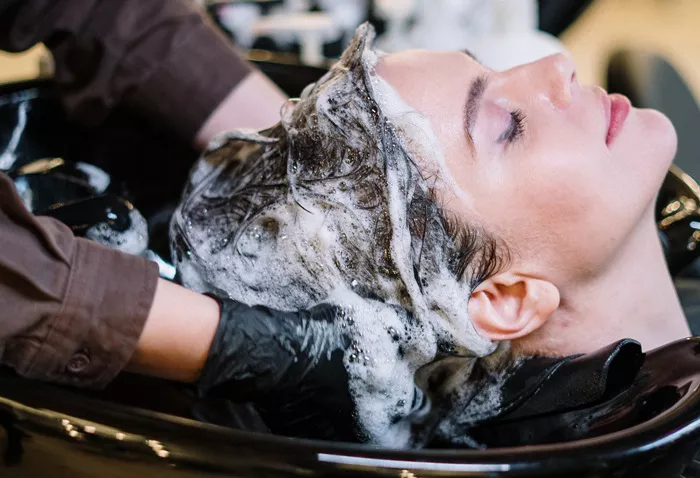Frizzy hair can be a persistent issue for many individuals, especially after shampooing. It often arises from a lack of moisture, damage, or environmental factors. If you struggle with frizzy hair after washing, you’re not alone. This comprehensive guide will explore effective strategies to combat frizz and achieve smooth, manageable hair.
Understanding Frizz
Frizz occurs when the hair cuticle (the outer layer of the hair strand) becomes raised and rough. This leads to an uneven surface that disrupts light reflection, resulting in a lack of shine and a frizzy appearance. Several factors contribute to frizz:
Lack of Moisture: Hair that lacks moisture is more likely to become frizzy. Dry hair cuticles can swell and lift, causing frizz.
Heat Damage: Excessive use of heat styling tools can damage the hair cuticle, leading to frizz.
Humidity: High humidity levels can cause hair to absorb moisture from the air, leading to frizz.
Chemical Treatments: Coloring, perming, and relaxing treatments can weaken hair, making it more prone to frizz.
Over-Washing: Frequent shampooing can strip hair of its natural oils, leading to dryness and frizz.
Choose the Right Shampoo and Conditioner
Select Moisturizing Products
To combat frizz, start with a nourishing shampoo and conditioner designed for dry or frizzy hair. Look for products that contain hydrating ingredients like glycerin, hyaluronic acid, and natural oils. These ingredients help retain moisture and smooth the hair cuticle.
Avoid Sulfates
Sulfates are harsh cleansing agents found in many shampoos. They can strip hair of its natural oils, exacerbating frizz. Opt for sulfate-free shampoos to maintain moisture balance and reduce frizz.
Adjust Your Shampooing Routine
Wash Less Frequently
Shampooing too often can strip hair of its natural oils, leading to dryness and frizz. Aim to wash your hair 2-3 times a week or less, depending on your hair type and lifestyle.
Use Lukewarm Water
Hot water can damage the hair cuticle and lead to frizz. Use lukewarm water to wash your hair, as it is gentler on the hair and helps retain moisture.
Condition Effectively
Deep Conditioning Treatments
Incorporate deep conditioning treatments into your routine to provide extra moisture and nourishment. Use a deep conditioner or hair mask once a week to help repair damage and reduce frizz.
Leave-In Conditioners
Apply a leave-in conditioner after washing your hair. Leave-in conditioners help maintain moisture and smooth the hair cuticle, reducing frizz throughout the day.
Avoid Heat Damage
Limit Heat Styling
Excessive use of heat styling tools like flat irons, curling wands, and blow dryers can damage the hair cuticle and increase frizz. Reduce heat styling or use tools on the lowest heat setting possible.
Use Heat Protectants
When using heat styling tools, always apply a heat protectant spray or serum. These products create a barrier between the heat and your hair, reducing the risk of damage and frizz.
Dry Hair Properly
Pat Dry, Don’t Rub
After washing your hair, gently pat it dry with a soft towel instead of rubbing it. Rubbing can roughen the hair cuticle and increase frizz.
Avoid Using a Rough Towel
Use a microfiber towel or an old cotton t-shirt to dry your hair. These materials are gentler on the hair and help reduce frizz compared to rough towels.
Air Dry or Use a Blow Dryer with Care
Whenever possible, allow your hair to air dry. If you need to use a blow dryer, use the lowest heat setting and a diffuser attachment to minimize heat damage and frizz.
Embrace the Right Styling Techniques
Use Anti-Frizz Products
Incorporate anti-frizz serums, oils, or creams into your styling routine. These products help smooth the hair cuticle and control frizz. Apply them to damp hair before styling or to dry hair for added shine and smoothness.
Avoid Over-Styling
Excessive styling can exacerbate frizz. Keep hairstyles simple and avoid excessive use of styling products that can weigh hair down and lead to build-up.
Protect Your Hair from Environmental Factors
Use UV Protection
Exposure to sunlight can damage the hair cuticle and increase frizz. Use hair products with UV protection or wear a hat to shield your hair from harmful UV rays.
Protect Hair from Humidity
In humid conditions, use anti-frizz sprays or serums that are designed to combat humidity and keep hair smooth. These products create a barrier that helps prevent moisture from disrupting the hair cuticle.
See also: Which Pantene Shampoo Is Best for Hair Fall?
Address Hair Health
Regular Trims
Regular trims help remove split ends and prevent further damage, which can contribute to frizz. Aim to trim your hair every 6-8 weeks to maintain healthy ends and reduce frizz.
Healthy Diet
A balanced diet rich in vitamins and minerals supports overall hair health. Incorporate foods high in omega-3 fatty acids, vitamins A, C, and E, and biotin to promote strong, hydrated hair.
Experiment with Natural Remedies
Oils and Masks
Natural oils like coconut oil, argan oil, and olive oil can be used as pre-shampoo treatments or added to your hair care routine to provide extra moisture and reduce frizz. Apply the oil to your hair, leave it on for at least 30 minutes, and then wash it out with shampoo.
Homemade Hair Masks
Create your own hair masks using ingredients like honey, avocado, and yogurt. These natural ingredients provide deep hydration and nourishment, helping to combat frizz and improve hair texture.
Conclusion
Managing frizzy hair after shampooing requires a combination of the right products, techniques, and habits. By selecting moisturizing shampoos and conditioners, avoiding heat damage, drying hair properly, and incorporating anti-frizz products, you can achieve smooth, manageable hair. Additionally, protecting your hair from environmental factors, maintaining a healthy diet, and experimenting with natural remedies can further enhance your efforts to reduce frizz. With these strategies, you can enjoy healthier, more beautiful hair every day.


